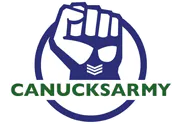Nation Sites
The Nation Network
CanucksArmy has no direct affiliation to the Vancouver Canucks, Canucks Sports & Entertainment, NHL, or NHLPA
What should the Canucks do at the NHL Trade Deadline?: Canucks Conversation

Photo credit: Jerome Miron-Imagn Images
Feb 26, 2025, 09:00 ESTUpdated: Feb 26, 2025, 00:01 EST
On today’s episode of Canucks Conversation, David Quadrelli and Harman Dayal broke down how the Vancouver Canucks should approach the trade deadline with 10 days to go and approximately $10 million in cap space. With Vancouver sitting in the Wild Card race rather than firmly in a contending position, the conversation centred around whether the team should buy, sell, or take a more patient approach.
Quads opened the discussion by reflecting on the team’s original plans compared to where they stand now.
“Before the season, they got rid of Tucker Poolman and were accruing cap space because they were going to be able to add a top-four defenceman at the deadline,” Quads said. “We didn’t see them being in the Wild Card race and thought that first-round pick was as good as gone, but it doesn’t look that way anymore.”
With the team’s position less certain, Harm pointed out that Vancouver’s cap flexibility gives them multiple options beyond just acquiring win-now talent.
“There are different ways you can leverage [cap space],” Harm explained. “If you’re the Canucks and come to the realization that you can’t extend Brock Boeser at a price you like, we don’t want to see the Canucks keep him as a rental. So if you’re going to trade him, you can retain 50% of his salary, which increases the pool of potential buyers and allows you to get more value back.
“That’s one way to leverage the flexibility they’re accruing ahead of the deadline. The other thing is, yes, they should be scouring the market for upside non-rental players, but if they can’t find the right fit, there shouldn’t be an urgency to spend just because they have cap space. This team doesn’t fit the profile of a realistic Cup contender this year; they’re not a piece or two away from getting that done.
“Even when you look at the trade pool, it’s not an impressive list of targets. Unless there are unforeseen opportunities — which can happen; no one thought Filip Hronek was available when the Canucks pounced on him — the organization shouldn’t spend just for the sake of spending.”
If the Canucks decide to move on from Boeser at the deadline, Harm believes there’s a way to do so without waving the white flag on the season.
“They’re neither a classic buyer nor a seller ahead of this deadline,” he said. “In a perfect world, you’d emulate what the Capitals did with Dmitry Orlov when he was a pending UFA — they dealt him to Boston for a first-round pick and flipped that pick for Rasmus Sandin. At the time, Sandin wasn’t as good as Orlov, but he was younger, cost-controlled, and grew into Orlov’s exact role. He helped them that season, but more importantly, he was part of their long-term future.
“Even if you can’t find that perfect Sandin equivalent for a top-six winger, the other option is paying a mid-round pick for a cheap, top-nine stopgap contributor. A guy like Alex Iafallo in Winnipeg — when he was in LA, he was a really consistent 40-point producer. Now he’s buried on the fourth line on the Jets. They could look to ship him out to open up more flexibility, and based on his track record in LA, he could easily slide in and be a fine top-nine guy.
“Is he as good as Brock Boeser? Absolutely not. But if you’re trying to find the sweet spot — trading Boeser but not completely waving the white flag on the season — that’s one way to do it. You’re going to get a significant return for Boeser and trade a mid-round pick for a player like Iafallo.”
With cap space available but no clear path to contending, the Canucks’ approach to this year’s deadline will be crucial
You can watch the full segment below:
Sponsored by bet365
Breaking News
- Quinn Hughes talks thought process in lead-up and aftermath of trade from Canucks to Wild
- Wagner’s Weekly: After Hughes trade, which Canuck will get traded next?
- The Stanchies: Zeev Buium’s two point debut leads the way in Canucks’ 2-1 victory over Devils
- Canucks forward Lukas Reichel clears waivers
- Instant Reaction: Zeev Buium scores game-winning goal in Canucks debut vs. Devils
